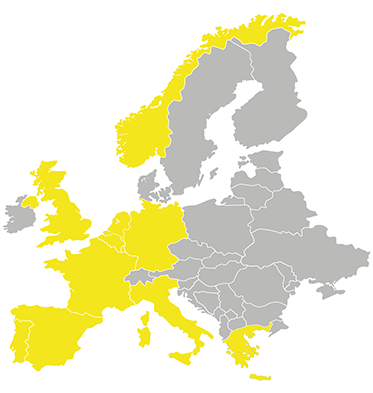Rather not read? Watch the full interviews.
Increase bioeconomy competitiveness by developing tech and promoting products
“There is a strong competition from the petrochemical sector in terms of raw material costs and processing costs. So there is a big question of competitiveness. Overcoming that is difficult: you can either implement a regulation – people must use it, and that’s it, and they pay the price – or you let technologies develop and you push or promote these kinds of products. And I think that’s probably the best way. We still need to be competitive, so maturity of the technology is very important.” – Anne Wagner, R&D Director at Tereos
Combine the right technologies for the optimal treatment of biomass
“We must find milder treatment systems for feedstock than we used before. For two reasons: ‘milder’ means that we keep more functionality, and that is exactly what nature gives us. So if we lose that, we lose the benefits of biomass. And if we use milder technologies, it also means that we have less energy consumption and less destruction of biomass. So this is really the challenge: to combine this. The best technology to use depends on your final use. There are disadvantages to every technology. It will really depend on what you want to do for your final end consumers.” – Ludo Diels, Research Leader at VITO
Focus on using renewable raw materials to create sustainable processes and products
“The greatest challenge for me is climate change. We must adapt and we must struggle very efficiently against climate change. What has changed during the past 10 years, is that we need to make sustainable processes and sustainable products. This can be achieved through the use of renewable raw materials and renewable products, biosourced products. This will make the difference, regardless of any price of an oil barrel.” – Pierre Monsan, Director at Toulouse White Biotechnology (TWB)
Focus on creating better products, not on the way they are produced
“I’ve been in this sector since about 2007. At that time, everyone was talking about drop-in chemicals. People were scared about accessing new markets, so they wanted to avoid the questions about market accessibility. Whereas as you discuss with people today, this is a taboo word. Now, everybody is about differentiation and better performing products. I think this strategic change has taken some time. This is why we’ve seen some disappointing stories. But now, we see emerging new companies – what I would call the second or the third wave of the bioeconomy – that will drive for better products, more than biobased products. Biobased is more a consequence, or one of the features; but the real key is that the product is more efficient, or cheaper, or more sustainable, or can deliver better performance.” – Michael Krel, Principal at Sofinnova
Collaborate to overcome economic challenges
“The first one is an economical challenge. This means a process to densify or to fractionate the biomass: is this process bringing me the product at a value that is compatible with market value? The second thing is energy. The solutions are more or less ongoing, theoretically speaking. Practically speaking, it’s another story. But theoretically speaking, the solutions are ongoing. For example, through the Joint Undertaking Initiative in bioeconomy between industry and the European Commission.” – Yvon Le Henaff, Chairman at IAR
Create the proper logistics for feedstock supply, and ensure consumer buy-in
“For the feedstock supply, there is a competition with food, but also the reliability of supply, both qualitatively and quantatively. Because if you have a process, you need to fill it with the right amount and right quality of feedstock. The logistics are important – but often you have the feedstock, but not the logistics in place to transport from where it originated to where it is going in good economical condition. There is also a challenge at the end of the value chain: consumer willingness to use biobased products is critical. We see today that there is a lot of interest, but also a lot of confusion. We need to make an effort to clarify the model, and maybe put in place some specific label or something similar.” – Philippe Mengal, Executive Director at BBI-JU
Scale up through creating a healthy bioeconomy ecosystem
“We talked a lot about the importance of scale. We will learn more about what it takes to scale up technology. But it will take a lot of cross-sectional knowledge. It will require a big ecosystem to enable different areas of expertise to bring products to market. I think it will take having collaborators who can bring in complementary core competencies; having partners who believe in launching products that add value to the world; investors willing to take at-risk investments to bring emerging technologies to market. All that is part of the ecosystem that is necessary to bring new forms of science and technology advancements to the world.” – Ena Cratsenburg, Chief Business Officer at Ginkgo Bioworks
Increase economic competitiveness through policy and stakeholder involvement
“The main challenge, overall, is basic economic competitiveness: bioeconomy against fossil. It’s very hard to compete with something that comes out of the ground by itself. Specifically for Europe, there are additional economic competitive issues against the other big bioeconomy players, so as the Brazil, USA or South East Asia, which have scale and deregulation. So the main driver is a problem of cost – Europe tends to be rather expensive – and regulatory stability – Europe tends to be complex and often not stable. Putting steel on the ground and investing in big plants requires proper assurances: financial support and stability of legislation, mandates and bans. That requires engagement from the policy makers, which is getting there. A bigger footprint will probably be achieved if different stakeholders can be involved. In particular groups that are not aware of the term bioeconomy. The ability of the bioeconomy to speak to those groups will be quite an asset.” – Filippo Giancarlo Martinelli, PNO Consultants
Do you want to know what else the leading experts had to say on the development of the bioeconomy or key enabling technologies? Watch the full interviews.
Not a video person? You can also download the epaper.




